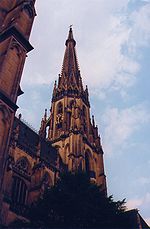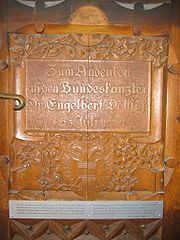
New Cathedral, Linz
Encyclopedia

Linz
Linz is the third-largest city of Austria and capital of the state of Upper Austria . It is located in the north centre of Austria, approximately south of the Czech border, on both sides of the river Danube. The population of the city is , and that of the Greater Linz conurbation is about...
was begun in 1855 by Bishop Franz Joseph Rudigier. The first stone was laid in 1862, and in 1924 Bishop Johannes Maria Gföllner consecrated the finished building as the Cathedral of the Virgin Mary (Mariendom). The plans, drawn by the Master Builder of the Archdiocese of Cologne, Vincenz Statz, were made in the French high gothic style.
With 20,000 seats, the cathedral is the largest, but not the highest, church in Austria
Austria
Austria , officially the Republic of Austria , is a landlocked country of roughly 8.4 million people in Central Europe. It is bordered by the Czech Republic and Germany to the north, Slovakia and Hungary to the east, Slovenia and Italy to the south, and Switzerland and Liechtenstein to the...
. The originally-planned, higher spire was not approved, because in Austria-Hungary
Austria-Hungary
Austria-Hungary , more formally known as the Kingdoms and Lands Represented in the Imperial Council and the Lands of the Holy Hungarian Crown of Saint Stephen, was a constitutional monarchic union between the crowns of the Austrian Empire and the Kingdom of Hungary in...
at the time, no building was allowed to be taller than the South Tower of the St. Stephen's Cathedral
Stephansdom
St. Stephen's Cathedral is the mother church of the Archdiocese of Vienna and the seat of the Archbishop of Vienna, Christoph Cardinal Schönborn, OP...
in Vienna
Vienna
Vienna is the capital and largest city of the Republic of Austria and one of the nine states of Austria. Vienna is Austria's primary city, with a population of about 1.723 million , and is by far the largest city in Austria, as well as its cultural, economic, and political centre...
. At 135 m, the New Cathedral is two meters shorter than the Viennese cathedral.

Also noteworthy is the nativity scene in the church burial vault, with its figures made by S. Osterrieder, and the display of the regalia of Bishop Rudigier.
Politics

OVP
OVP is a three-letter abbreviation that may refer to:*The Office of the Vice President of the United States*The Office of the Vice President of the Philippines*OVP , a light sub-machine gun developed in Italy...
. In the plaque the church, by resolution of the Austrian Conference of Catholic Bishops, distances itself from the original cut and proclaims the future abstention from party politics. Dollfuß as acting Chancellor of Austria
Chancellor
Chancellor is the title of various official positions in the governments of many nations. The original chancellors were the Cancellarii of Roman courts of justice—ushers who sat at the cancelli or lattice work screens of a basilica or law court, which separated the judge and counsel from the...
in 1933 eliminated the parliament over formal irregularities. This caused the Austrian Civil War
Austrian Civil War
The Austrian Civil War , also known as the February Uprising , is a term sometimes used for a few days of skirmishes between socialist and conservative-fascist forces between 12 February and 16 February 1934, in Austria...
and led to a dictatorship
Austrofascism
Austrofascism is a term which is frequently used by historians to describe the authoritarian rule installed in Austria with the May Constitution of 1934, which ceased with the forcible incorporation of the newly-founded Federal State of Austria into Nazi Germany in 1938...
.

